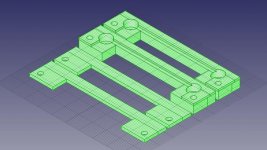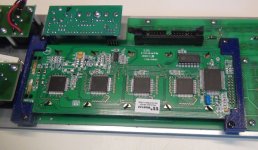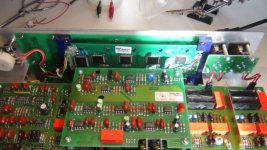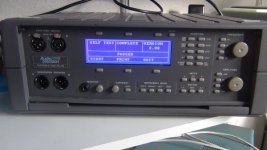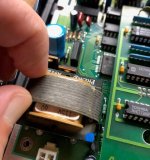hi all,
I have one of these beasts which I bought from a guy in Czech republic. It's an invaluable piece of test gear. So far I did a couple of hacks on it:
1. The display was dying, and I couldn't get a new one for a sensible price. I have retro-fitted a more modern display that uses the same controller (you wouldn't know from the outside). I designed some adaptors and 3D printed them to take care of mechanical issues. The new display uses low voltage backlight, so the internal high voltage inverter could be pulled out.
2. I built a gadget based on a PIC demo board to grab printer graphic output and save them to a USB stick. I can then use PrintCapture software (commercially available for about 70USD I think) to convert the files to PNG or whatever. Also possible to capture raw text like this, it would be possible to write a script so results could be pulled into CSV.
Now what I'd *really* like is to be able to automate the thing from PC - but almost impossible to find a GPIB card. I am wondering if it would be possible to make a USB adaptor that could plug into the GPIB card slot - so the AP would become programmable ... hmmm.
No real reason for all this except to share it. I'll see if I can find some pics. if anyone wants more info contact me. (I don't come by here very often, but if you google my name you'll find my website.)
cheers
Dan
I have one of these beasts which I bought from a guy in Czech republic. It's an invaluable piece of test gear. So far I did a couple of hacks on it:
1. The display was dying, and I couldn't get a new one for a sensible price. I have retro-fitted a more modern display that uses the same controller (you wouldn't know from the outside). I designed some adaptors and 3D printed them to take care of mechanical issues. The new display uses low voltage backlight, so the internal high voltage inverter could be pulled out.
2. I built a gadget based on a PIC demo board to grab printer graphic output and save them to a USB stick. I can then use PrintCapture software (commercially available for about 70USD I think) to convert the files to PNG or whatever. Also possible to capture raw text like this, it would be possible to write a script so results could be pulled into CSV.
Now what I'd *really* like is to be able to automate the thing from PC - but almost impossible to find a GPIB card. I am wondering if it would be possible to make a USB adaptor that could plug into the GPIB card slot - so the AP would become programmable ... hmmm.
No real reason for all this except to share it. I'll see if I can find some pics. if anyone wants more info contact me. (I don't come by here very often, but if you google my name you'll find my website.)
cheers
Dan
I'm based in the Czech Rep. I had no idea anyone else was into audio over here - can you say who you bought it from?
Nice work with designing 3D printed adapters - I'd guessed 3D printing was still to ruff and weak to be really useful? The parts I've seen had been printed by thin plastic "Wire" thats slowly layered up... but no way would it be used...
When you say GPIB card do you mean for your PC or for the AP P1?
Nice work with designing 3D printed adapters - I'd guessed 3D printing was still to ruff and weak to be really useful? The parts I've seen had been printed by thin plastic "Wire" thats slowly layered up... but no way would it be used...
When you say GPIB card do you mean for your PC or for the AP P1?
hi John
I'll PM you the name of the guy. He had two of them. I believe he works as a remastering engineer and used the AP mostly to line up tape machines before making transfers.
3D print is a very viable technology for small run of mechanical parts. These worked out really well. I had to make a couple of manual mods to avoid parts on the board that were in the way, which would have been easy to fix if I made a new set. As it is, they do the job very well. i was very pleased, considering it was my first use of the technology.
I would like to be able to automate the P1 - run test software to set the generator and read the meters. However reading up on it, I am pretty sure that the GPIB add-on also involves a firmware update, which I don't have, so that pretty much rules that out I think.
I'll PM you the name of the guy. He had two of them. I believe he works as a remastering engineer and used the AP mostly to line up tape machines before making transfers.
3D print is a very viable technology for small run of mechanical parts. These worked out really well. I had to make a couple of manual mods to avoid parts on the board that were in the way, which would have been easy to fix if I made a new set. As it is, they do the job very well. i was very pleased, considering it was my first use of the technology.
I would like to be able to automate the P1 - run test software to set the generator and read the meters. However reading up on it, I am pretty sure that the GPIB add-on also involves a firmware update, which I don't have, so that pretty much rules that out I think.
Attachments
Virtual serial port
I'm not sure if this is what you are looking for, but I've done this before and it's real easy.
This part from Microchip:
MCP2200 - USB Bridges
provides a super-easy interface to a PIC micro. When attached to the USB bus, it presents itself as a serial port, e.g., COM9, COM10, etc. The other side, 4 wires hooked to the micro, look like a standard serial port (TX, RX, CTS, RTS). Microchip has source code for serial I/O, but it's easy enough to roll your own.
You can buy these "virtual serial ports" chips already mounted on a breakout board, with clock, a female USB connector and 4-6 pads/pins/sockets for connecting to the PIC. Available from Sparkfun, Mouser, Digikey, ebay, etc. Glue this on top of the demo board, connect 4 wires, find serial I/O code and you're done.
The key question is can the PIC access the GPIB bus? I've not done this, but would think a GPIB interface (parallel?) would be relatively straightforward. Provided the PIC has enough PIO pins to do the job.
Just thinking out loud.
Mike
hi all,
<snip>
2. I built a gadget based on a PIC demo board
<snip>
Now what I'd *really* like is to be able to automate the thing from PC
<snip>
Dan
I'm not sure if this is what you are looking for, but I've done this before and it's real easy.
This part from Microchip:
MCP2200 - USB Bridges
provides a super-easy interface to a PIC micro. When attached to the USB bus, it presents itself as a serial port, e.g., COM9, COM10, etc. The other side, 4 wires hooked to the micro, look like a standard serial port (TX, RX, CTS, RTS). Microchip has source code for serial I/O, but it's easy enough to roll your own.
You can buy these "virtual serial ports" chips already mounted on a breakout board, with clock, a female USB connector and 4-6 pads/pins/sockets for connecting to the PIC. Available from Sparkfun, Mouser, Digikey, ebay, etc. Glue this on top of the demo board, connect 4 wires, find serial I/O code and you're done.
The key question is can the PIC access the GPIB bus? I've not done this, but would think a GPIB interface (parallel?) would be relatively straightforward. Provided the PIC has enough PIO pins to do the job.
Just thinking out loud.
Mike
Hello danmcb
I have the same unit with an LCD problem. Can you please point me to the replacement LCD that you used?
I have the same unit with an LCD problem. Can you please point me to the replacement LCD that you used?
hi to everyone that picked up on this - I intend to make all the info available via my website soon. I'll post a link here when I do and also DM the people that contacted me. Pretty busy but I hope to do this soon. Daniel
Hi Mike - well the issue is that if you don't have the GPIO interface (it was an add on I think, I don't have one) you are stuck with trying to make a clone that interfaces straight to the internal bus. Which is gonna take quite some work, more than I have time for anyway.
I'm not sure if this is what you are looking for, but I've done this before and it's real easy.
This part from Microchip:
MCP2200 - USB Bridges
provides a super-easy interface to a PIC micro. When attached to the USB bus, it presents itself as a serial port, e.g., COM9, COM10, etc. The other side, 4 wires hooked to the micro, look like a standard serial port (TX, RX, CTS, RTS). Microchip has source code for serial I/O, but it's easy enough to roll your own.
You can buy these "virtual serial ports" chips already mounted on a breakout board, with clock, a female USB connector and 4-6 pads/pins/sockets for connecting to the PIC. Available from Sparkfun, Mouser, Digikey, ebay, etc. Glue this on top of the demo board, connect 4 wires, find serial I/O code and you're done.
The key question is can the PIC access the GPIB bus? I've not done this, but would think a GPIB interface (parallel?) would be relatively straightforward. Provided the PIC has enough PIO pins to do the job.
Just thinking out loud.
Mike
The P1 is bench / portable mode test system. It is a MANUAL INPUT TEST SYSTEM. It has options to add 2 filters cards, Printer (Not great with today’s printers) & GPIB control. The options are not avaible from AP today.
If your P1 has GPIB installed then several GPIB-USB interfaces can be used. National Instruments & Agilent Technologies among others from $200 and up.
The biggest problem is NO REPLACEMENT DISPLAYS. All of the ANALOG parts are still easily to purchase; some of the digital parts for Dual Domain are scares. No service info from AP and this makes the task much harder and you may need other skilled help.
TIME is MONEY. If your time is free then try to complete the task.
I would take a look for a System One as a replacement. This instrument is FULLY CONTROLABLE via old or new computers via USB with my APIB USB ADAPTER (OS XP, VISTA, WIN 7, 8 & 10).
I worked for AP for many years as Senior Analog Engineer and designed several products.
Duke
If your P1 has GPIB installed then several GPIB-USB interfaces can be used. National Instruments & Agilent Technologies among others from $200 and up.
The biggest problem is NO REPLACEMENT DISPLAYS. All of the ANALOG parts are still easily to purchase; some of the digital parts for Dual Domain are scares. No service info from AP and this makes the task much harder and you may need other skilled help.
TIME is MONEY. If your time is free then try to complete the task.
I would take a look for a System One as a replacement. This instrument is FULLY CONTROLABLE via old or new computers via USB with my APIB USB ADAPTER (OS XP, VISTA, WIN 7, 8 & 10).
I worked for AP for many years as Senior Analog Engineer and designed several products.
Duke
- Home
- Design & Build
- Equipment & Tools
- Audio Precision P1 Plus hacks
